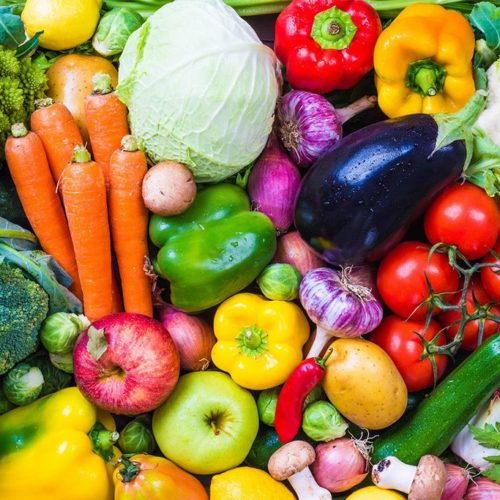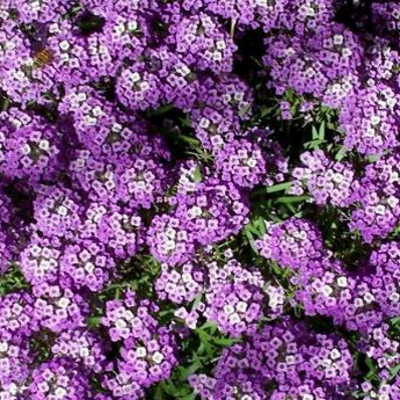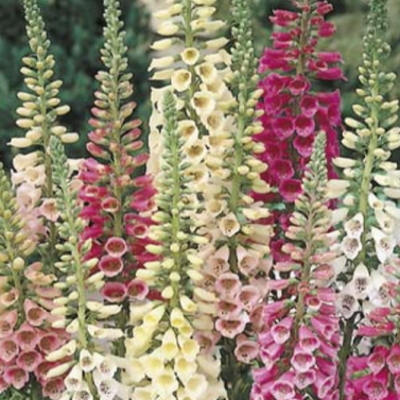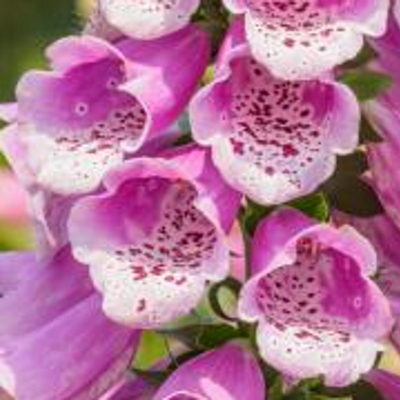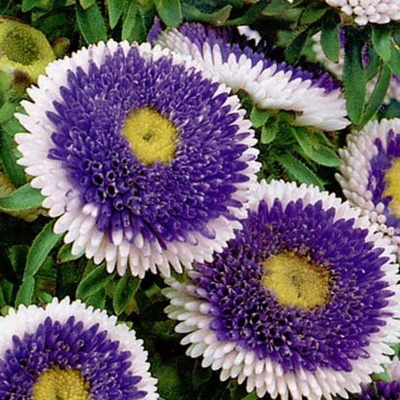-
Out of stock

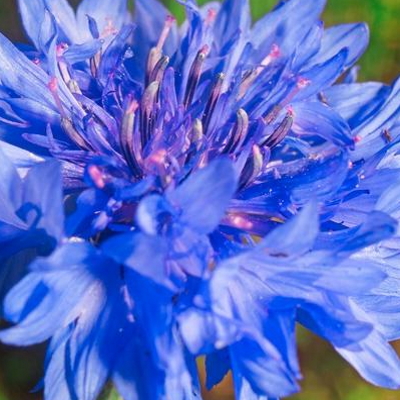 Bachelor's Button or Cornflower-It's hard to beat the colours of the bachelor's button. It got the name "cornflower" because it grew as a weed in cornfields, but you may welcome it in your garden. It does spread, but it is easy to pull out any extras. This tall 90 cm mix comes in the colours of purple, blue, pink and white provide papery blossoms that bring summer colour to the garden. They're attractive planted in a group in a corner or open spot in the garden. Deadhead regularly to prolong blooming. Plant periodically over spring to prolong bloom times.
Bachelor's Button or Cornflower-It's hard to beat the colours of the bachelor's button. It got the name "cornflower" because it grew as a weed in cornfields, but you may welcome it in your garden. It does spread, but it is easy to pull out any extras. This tall 90 cm mix comes in the colours of purple, blue, pink and white provide papery blossoms that bring summer colour to the garden. They're attractive planted in a group in a corner or open spot in the garden. Deadhead regularly to prolong blooming. Plant periodically over spring to prolong bloom times. -
Out of stock
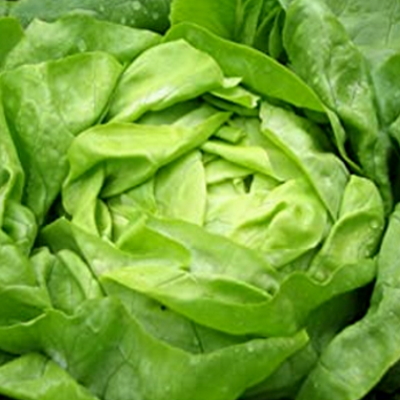 Buttercrunch is a real winner and always a favorite in our organic gardens. This is a butterhead type of lettuce with crisp, thick well-formed medium to dark green outer leaves which hides the buttery yellow-white heart. Buttercrunch has good resistance to bolting. For ultimate flavour and nutrition eat directly after picking. We found that all lettuce, especially our buttercrunch grows in moist rich organic compost. Spring lettuce is grown in sunny locations, while summer crops prefer light shade. Since lettuce is a cool-weather crop, sow the seed as soon as the soil can be worked in the spring then every two weeks thereafter to ensure a continuous supply. Sow seed about 3 mm deep. Head lettuce such as Buttercrunch should be thinned to 30 cm apart to provide ample nutrients and room for growth. An even supply of moisture during the entire growth period is imperative for success. Harvest head lettuce by cutting the head off at the base just below the lower leaves.
Buttercrunch is a real winner and always a favorite in our organic gardens. This is a butterhead type of lettuce with crisp, thick well-formed medium to dark green outer leaves which hides the buttery yellow-white heart. Buttercrunch has good resistance to bolting. For ultimate flavour and nutrition eat directly after picking. We found that all lettuce, especially our buttercrunch grows in moist rich organic compost. Spring lettuce is grown in sunny locations, while summer crops prefer light shade. Since lettuce is a cool-weather crop, sow the seed as soon as the soil can be worked in the spring then every two weeks thereafter to ensure a continuous supply. Sow seed about 3 mm deep. Head lettuce such as Buttercrunch should be thinned to 30 cm apart to provide ample nutrients and room for growth. An even supply of moisture during the entire growth period is imperative for success. Harvest head lettuce by cutting the head off at the base just below the lower leaves. -
Out of stock
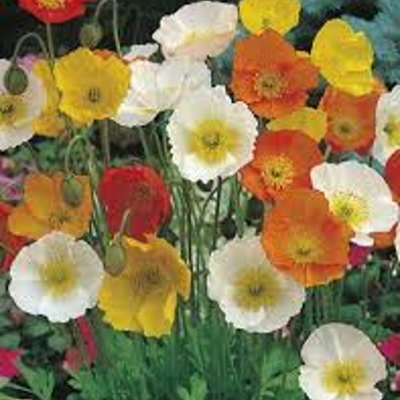 Papaver nudicaule. The Iceland Poppy is a hardy short-lived perennial. It self sows easily so will last for years to come. The cup-shaped blooms have a texture like crepe paper and appear in a range of subdued pastel colours; apricot, gold, tangerine, and white. Sow Iceland Poppy seeds in early spring or late fall where they are to grow permanently. The flower stalks grow to around 30cm tall and are among the longest-lasting poppies as cut flowers. Use a candlestick to seal the cut stem to prolong them as cut flowers. They are highly attractive to bees. Plant in late fall or early spring. Poppy seeds need to be cold stratified to germinate. Poppies only need soil that is ordinary and moist, but well-drained. The seeds should not be planted deeply; they just need to be compressed into the soil, as they need light to germinate. The best method for planting is to mix one part seed with 5 parts sand and scatter over the prepared growing area.
Papaver nudicaule. The Iceland Poppy is a hardy short-lived perennial. It self sows easily so will last for years to come. The cup-shaped blooms have a texture like crepe paper and appear in a range of subdued pastel colours; apricot, gold, tangerine, and white. Sow Iceland Poppy seeds in early spring or late fall where they are to grow permanently. The flower stalks grow to around 30cm tall and are among the longest-lasting poppies as cut flowers. Use a candlestick to seal the cut stem to prolong them as cut flowers. They are highly attractive to bees. Plant in late fall or early spring. Poppy seeds need to be cold stratified to germinate. Poppies only need soil that is ordinary and moist, but well-drained. The seeds should not be planted deeply; they just need to be compressed into the soil, as they need light to germinate. The best method for planting is to mix one part seed with 5 parts sand and scatter over the prepared growing area. -
Out of stock
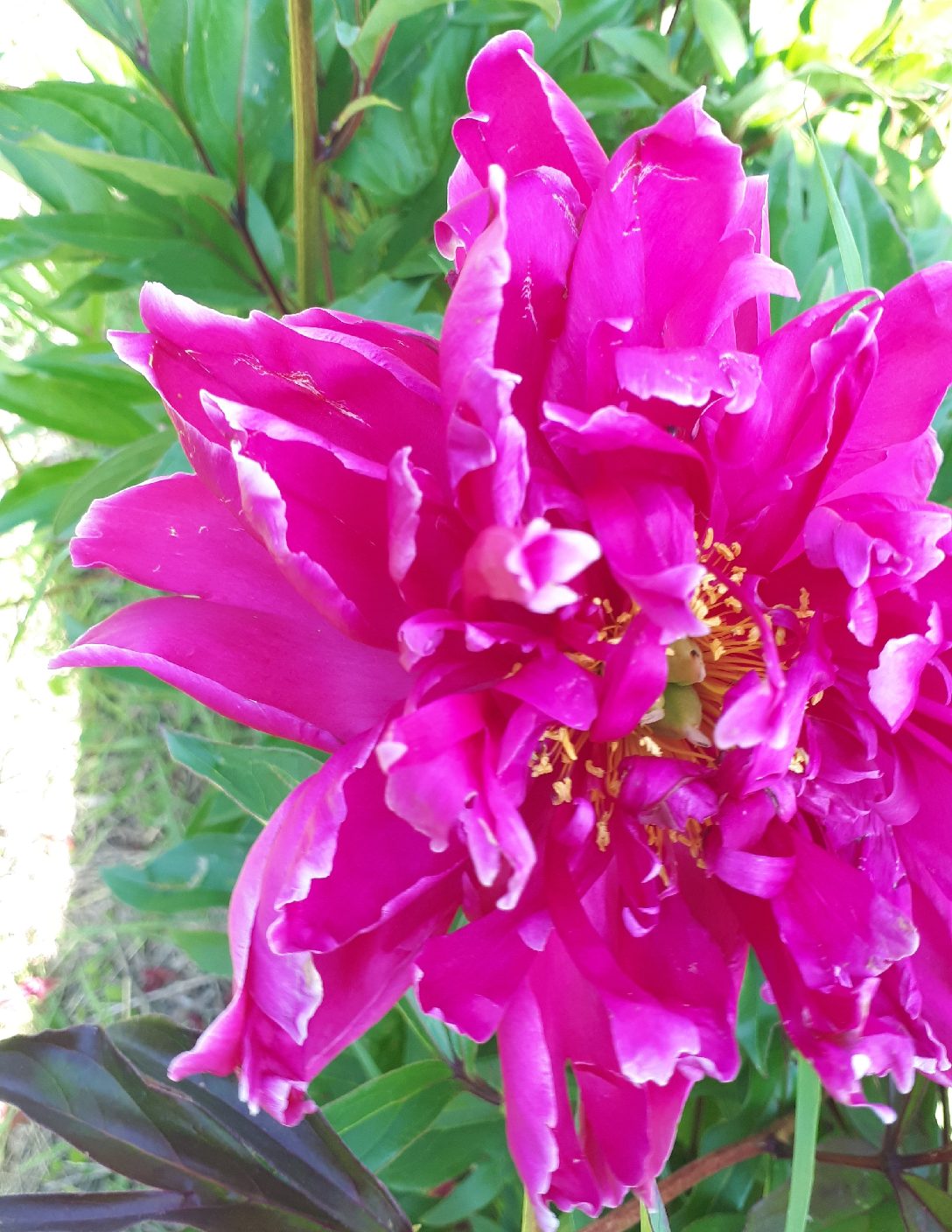
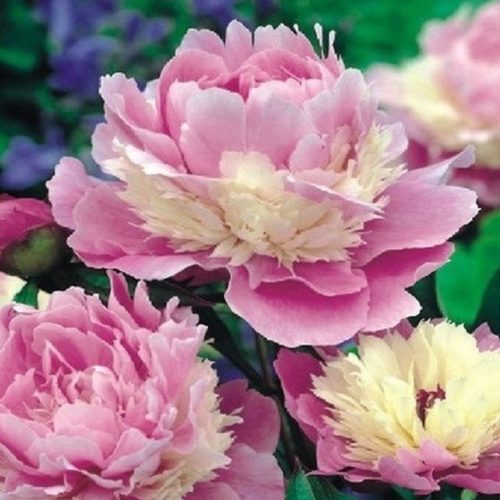 Mixed heritage variety peony plants. $10.00 each root or 5 roots for $35.00
Mixed heritage variety peony plants. $10.00 each root or 5 roots for $35.00 -
Out of stock
 Enjoy a baby's breath that is actually pink! Plant in your sunny perennial garden and watch as large panicles of true light pink flowers splash your garden from early through midsummer. This upright, well-branched, bush type grows up to 3' tall. Use as a filler plant to cover dying bulb foliage or for perennials that go dormant in the summer months. The pretty pink flowers also are perfect in floral arrangements! Makes an excellent dried flower.
Enjoy a baby's breath that is actually pink! Plant in your sunny perennial garden and watch as large panicles of true light pink flowers splash your garden from early through midsummer. This upright, well-branched, bush type grows up to 3' tall. Use as a filler plant to cover dying bulb foliage or for perennials that go dormant in the summer months. The pretty pink flowers also are perfect in floral arrangements! Makes an excellent dried flower. -
Out of stock
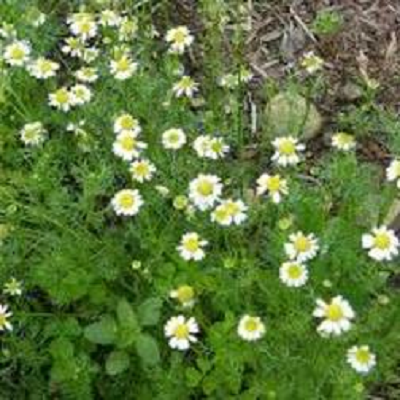
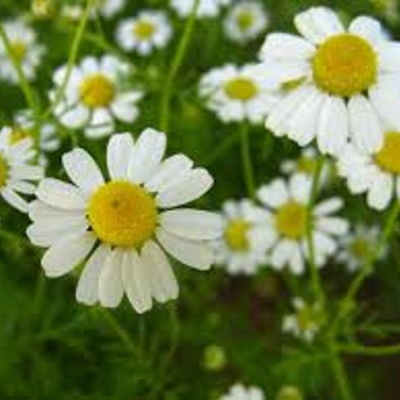 65 days. Matricaria recutita. Annual. The plant is used fresh and dried to make great tea, perfumes, and hair rinse. This variety produces high yields of small white daisy-like flowers. Try fresh chamomile steeped and chilled for a refreshing summer beverage. Package contains: 100 Seeds
65 days. Matricaria recutita. Annual. The plant is used fresh and dried to make great tea, perfumes, and hair rinse. This variety produces high yields of small white daisy-like flowers. Try fresh chamomile steeped and chilled for a refreshing summer beverage. Package contains: 100 Seeds -
Out of stock
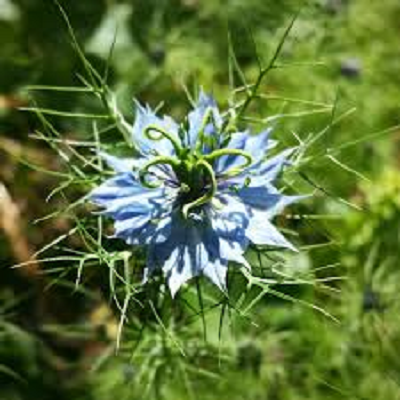
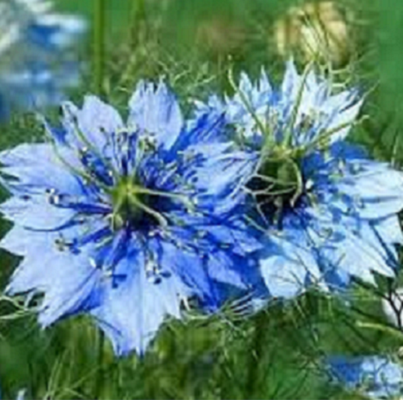 Nigella damascena. Persian Jewels Nigella seeds are also known as Love-in-a-Mist. Its delicate appearance belies its hardy, dependable nature. Pale as a baby flower, Persian Jewel matures to intense shades of violet, blue, white, and pastels in between. Each flower emerges from a tangle of lacy foliage. After blooming, curious-looking fruits ripen, dry, and eventually release seeds for the next season. These distinctive seed heads can be dried for flower arrangements. Everlasting flowers are grown especially for its spiky decorative seed pods. Germinates 10–14 days at 60°. Grow on at 60–65°. Set transplants 6–9" apart. For continuous bloom, direct seed weekly until June. Nigella grows 20–50cm (8–20") tall.
Nigella damascena. Persian Jewels Nigella seeds are also known as Love-in-a-Mist. Its delicate appearance belies its hardy, dependable nature. Pale as a baby flower, Persian Jewel matures to intense shades of violet, blue, white, and pastels in between. Each flower emerges from a tangle of lacy foliage. After blooming, curious-looking fruits ripen, dry, and eventually release seeds for the next season. These distinctive seed heads can be dried for flower arrangements. Everlasting flowers are grown especially for its spiky decorative seed pods. Germinates 10–14 days at 60°. Grow on at 60–65°. Set transplants 6–9" apart. For continuous bloom, direct seed weekly until June. Nigella grows 20–50cm (8–20") tall. -
Out of stock
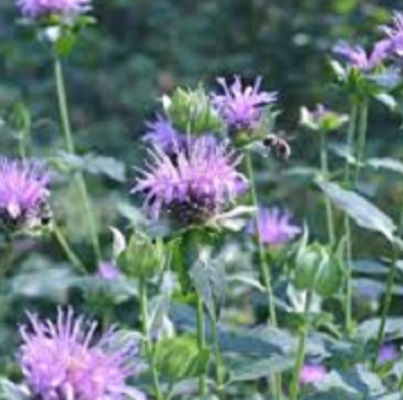 A bee magnet, softly aromatic leaves, and colourful flower heads are just a few lovely characteristics of Bee Balm (Monarda). Guaranteed to create a great impact when planted in masses with its starry explosions of colour burst from mid-summer through until the last frost. Known as bergamot. Leaves can be used in the kitchen before flowers appear.
A bee magnet, softly aromatic leaves, and colourful flower heads are just a few lovely characteristics of Bee Balm (Monarda). Guaranteed to create a great impact when planted in masses with its starry explosions of colour burst from mid-summer through until the last frost. Known as bergamot. Leaves can be used in the kitchen before flowers appear. -
-
Out of stock
 The earliest and best white spine cucumber ever offered, Early Fortune Organic is a fresh and clean tasting slicer is descended from seeds first bred in Michigan in 1906. The fruits grow 18-21cm long, and 5cm in diameter. The plants are richly productive for the home or market gardener. The plants are productive in the greenhouse or polytunnel, but equally so growing in raised beds or the open field. Give the fruits a quick rub with a tea towel or similar cloth to remove spines at harvest time.
The earliest and best white spine cucumber ever offered, Early Fortune Organic is a fresh and clean tasting slicer is descended from seeds first bred in Michigan in 1906. The fruits grow 18-21cm long, and 5cm in diameter. The plants are richly productive for the home or market gardener. The plants are productive in the greenhouse or polytunnel, but equally so growing in raised beds or the open field. Give the fruits a quick rub with a tea towel or similar cloth to remove spines at harvest time. -
Out of stock
 Strawberry Spinach is one of the best-kept secrets of the herb world. A herb that dates back to the 1600s in North America and northern Europe, this annual sets tiny, deliciously tender leaves that can be cooked like spinach or used fresh in salads. It also sets small red fruits in late summer and fall that taste a bit like mulberries which are lovely fresh or canned. A delectable and useful plant, you'll want it front and center of the herb garden! Strawberry Spinach sets new leaves all season long. The foliage is slender, deeply lobed, and appears in rosettes along long, slender stems. Quite small, they resemble small raspberries with a bright strawberry-red colour! The berries arise at the base of each stem and having berries on spinach plants is uniquely interesting! Direct sow Strawberry Spinach in full sun and rich, fertile soil. It reaches about 45 cm high and 30 cm wide. Easy and trouble-free.
Strawberry Spinach is one of the best-kept secrets of the herb world. A herb that dates back to the 1600s in North America and northern Europe, this annual sets tiny, deliciously tender leaves that can be cooked like spinach or used fresh in salads. It also sets small red fruits in late summer and fall that taste a bit like mulberries which are lovely fresh or canned. A delectable and useful plant, you'll want it front and center of the herb garden! Strawberry Spinach sets new leaves all season long. The foliage is slender, deeply lobed, and appears in rosettes along long, slender stems. Quite small, they resemble small raspberries with a bright strawberry-red colour! The berries arise at the base of each stem and having berries on spinach plants is uniquely interesting! Direct sow Strawberry Spinach in full sun and rich, fertile soil. It reaches about 45 cm high and 30 cm wide. Easy and trouble-free. -
Out of stock
 This carrot’s beautiful red-purple exterior provides a striking contrast to its yellow-orange interior and light yellow core. A treat for the eye when sliced, its sweet, almost spicy, flavour makes this carrot a home gardener’s favorite. Considered the most refined purple carrot available. Danvers carrots were developed in the 1870s in Danvers, Massachusetts. It became a popular seed due to the root's deep orange color and rich flavor. This variety does better than many popular carrots because it forms nice roots even in heavy, shallow soils. Purple Dragon carrots are considered to be very hardy and tend to do best in cooler northern regions.
This carrot’s beautiful red-purple exterior provides a striking contrast to its yellow-orange interior and light yellow core. A treat for the eye when sliced, its sweet, almost spicy, flavour makes this carrot a home gardener’s favorite. Considered the most refined purple carrot available. Danvers carrots were developed in the 1870s in Danvers, Massachusetts. It became a popular seed due to the root's deep orange color and rich flavor. This variety does better than many popular carrots because it forms nice roots even in heavy, shallow soils. Purple Dragon carrots are considered to be very hardy and tend to do best in cooler northern regions. -
Out of stock
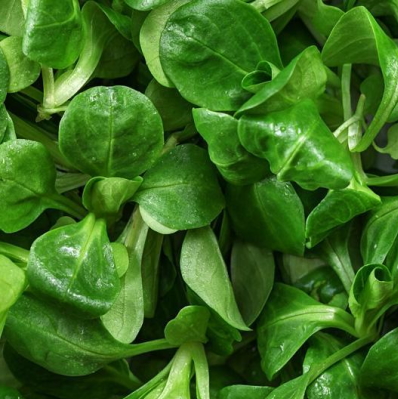 Organic, known as lambs lettuce. Long, glossy, leaves form heavy bunches with a mild flavour. Vigorous variety for spring and fall crops as well as over-wintering. Resistant to mildew. 25-35 days for small leaves and 50 days to mature. The small, pretty, tender green leaves of this green form a rosette that is very cold hardy. It has a mild and nutty flavour and can be planted in early spring and again in late August. This extra cold-tolerant vegetable can withstand temperatures up to -29C. It can be used during winters although a cold frame or greenhouse should be used if freezing rain, wind, or heavy winds are a concern. Corn Salad is one of the best crops to grow when fresh salads are to be enjoyed over the winter months. These delightful European native plants grow in autumn and even in winter when fresh vegetables are scarce. It perishes quickly after picking, usually lasting only 2-5 days in a fridge, so it is best to pick and eat the same day.
Organic, known as lambs lettuce. Long, glossy, leaves form heavy bunches with a mild flavour. Vigorous variety for spring and fall crops as well as over-wintering. Resistant to mildew. 25-35 days for small leaves and 50 days to mature. The small, pretty, tender green leaves of this green form a rosette that is very cold hardy. It has a mild and nutty flavour and can be planted in early spring and again in late August. This extra cold-tolerant vegetable can withstand temperatures up to -29C. It can be used during winters although a cold frame or greenhouse should be used if freezing rain, wind, or heavy winds are a concern. Corn Salad is one of the best crops to grow when fresh salads are to be enjoyed over the winter months. These delightful European native plants grow in autumn and even in winter when fresh vegetables are scarce. It perishes quickly after picking, usually lasting only 2-5 days in a fridge, so it is best to pick and eat the same day. -
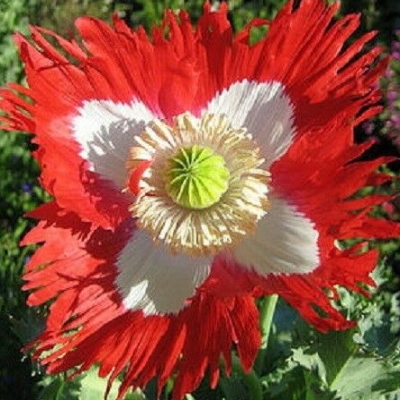 Enormous flowers reach 15 cm across. Each one is intricately crinkled and feathered or frilled, of unbelievably vivid scarlet, and at the center of each is a large, snow-white cross. The variety does indeed resemble the national flag of Denmark, which consists of a white cross on a scarlet field. Flowers attain a height of about 75 cm. Breathtaking in mass plantings! Use candlestick to seal stems when using for cut flowers to help cut blooms last longer.
Enormous flowers reach 15 cm across. Each one is intricately crinkled and feathered or frilled, of unbelievably vivid scarlet, and at the center of each is a large, snow-white cross. The variety does indeed resemble the national flag of Denmark, which consists of a white cross on a scarlet field. Flowers attain a height of about 75 cm. Breathtaking in mass plantings! Use candlestick to seal stems when using for cut flowers to help cut blooms last longer. -
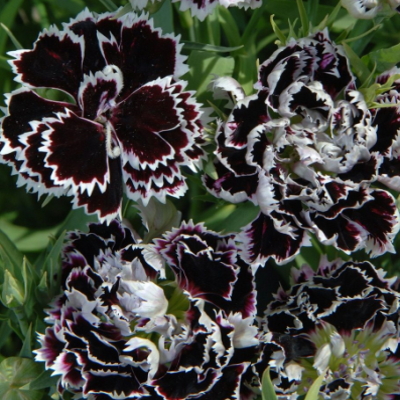 Hardy annual. Dainty, fully double blooms in deepest maroon, almost black, edged in brilliant white. The margins of the petals are heavily frilled, and the overall effect is one of great dignity and refinement, yet stunning beauty. The 2-3 cm blooms are sweetly fragrant. Makes a fine cut flower but really shines in a massed planting. Compact plants, the flowers are held above the grass-like foliage, reaching about a foot in height.
Hardy annual. Dainty, fully double blooms in deepest maroon, almost black, edged in brilliant white. The margins of the petals are heavily frilled, and the overall effect is one of great dignity and refinement, yet stunning beauty. The 2-3 cm blooms are sweetly fragrant. Makes a fine cut flower but really shines in a massed planting. Compact plants, the flowers are held above the grass-like foliage, reaching about a foot in height. -
Out of stock
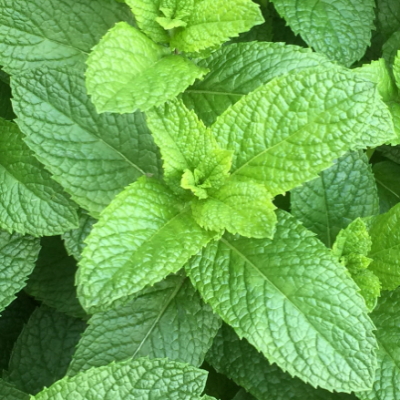 Spearmint came to North America with the Colonists. They used mint teas medicinally for headaches, indigestion and to help them sleep. Mint is also an excellent culinary addition and makes a great tea for the pure pleasure of it. As a general rule, mint family plants root vigorously when allowed to grow freely and can be invasive. Many gardeners grow them in containers to keep them in check.
Spearmint came to North America with the Colonists. They used mint teas medicinally for headaches, indigestion and to help them sleep. Mint is also an excellent culinary addition and makes a great tea for the pure pleasure of it. As a general rule, mint family plants root vigorously when allowed to grow freely and can be invasive. Many gardeners grow them in containers to keep them in check. -
-
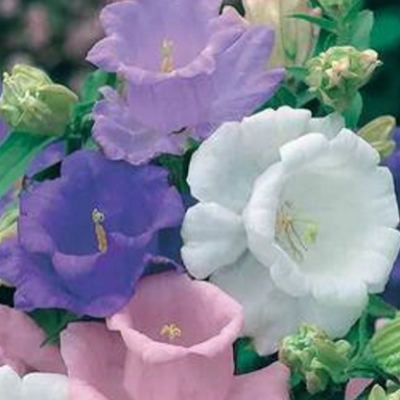 Canterbury Bells Cup and Saucer Mix is a hardy, attractive biennial flowering plant. Canterbury Bells seeds are a good way to establish this flowering bellflower mix that produces bell-shaped flowers with a flat base in various shades of blue, pink, and white. Canterbury Bells is the biennial, so the plant produces foliage the first year and flowers the second year blooming from spring to early summer.
Canterbury Bells Cup and Saucer Mix is a hardy, attractive biennial flowering plant. Canterbury Bells seeds are a good way to establish this flowering bellflower mix that produces bell-shaped flowers with a flat base in various shades of blue, pink, and white. Canterbury Bells is the biennial, so the plant produces foliage the first year and flowers the second year blooming from spring to early summer. -
-
Out of stock
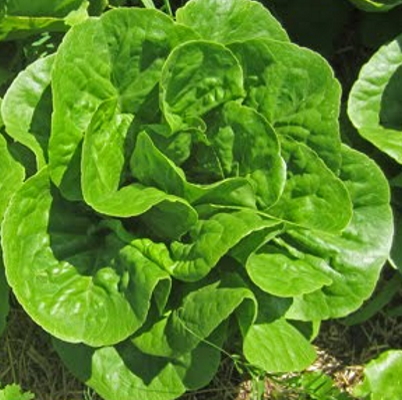 Winter Density is an early, small compact romaine. Its dark green leaves with an upright growth habit build a 20 cm tall densely packed head. You can count on Winter Density to be delectable butterhead/romaine cross is frost tolerant. Since it is bolt resistant and suited to all sowing dates and a great variety for spring, summer, and fall production. Perfect size for small families. Pick small outside leaves or harvest the whole head.
Winter Density is an early, small compact romaine. Its dark green leaves with an upright growth habit build a 20 cm tall densely packed head. You can count on Winter Density to be delectable butterhead/romaine cross is frost tolerant. Since it is bolt resistant and suited to all sowing dates and a great variety for spring, summer, and fall production. Perfect size for small families. Pick small outside leaves or harvest the whole head. -
Out of stock
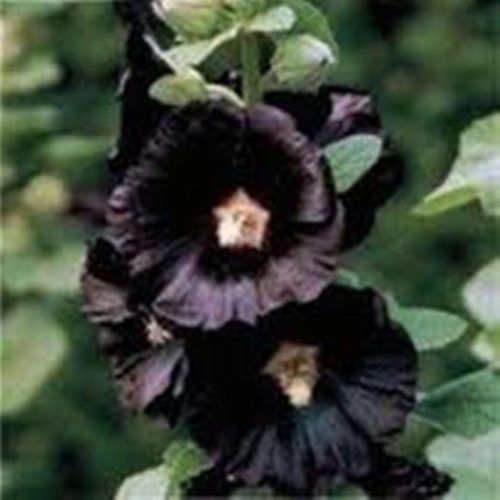 Biennial. This traditional variety is shockingly beautiful and richly coloured with its near-black flowers with just a hint of red. Gorgeous planted in the back of your flower bed or next to white buildings white flowers. A must for historical gardens.
Biennial. This traditional variety is shockingly beautiful and richly coloured with its near-black flowers with just a hint of red. Gorgeous planted in the back of your flower bed or next to white buildings white flowers. A must for historical gardens. -
Out of stock
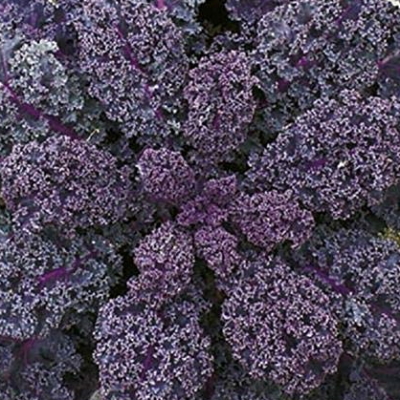
The broad, frilly, purple leaves grow on 60-90 cm tall, upright stalks. Red color on a blue-green background. Great for baby leaf and bunching. Scarlet has great flavour either as baby leaf or mature kale, and the flavour improves after frost. This kale is a must in an organic garden and is highly decorative in salads and stir-fries. Plant Scarlet kale in cow pots 4-6 weeks before the last frost, direct sow in early spring, and in mid-July for a fall crop. Scarlet Kale can grow 60-90 cm high. Boiling kale loses much of the nutritious properties while steaming and microwaving keep more cancer-fighting properties.
-
Out of stock
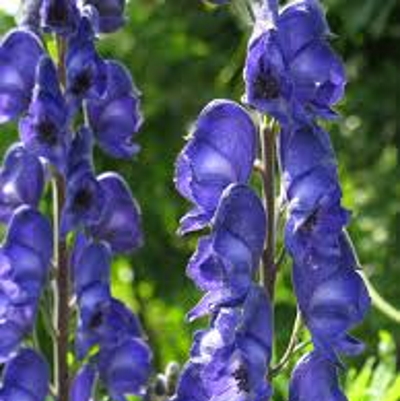 The monkshood plant is an herbaceous wildflower that can be found growing in mountain meadows throughout the northern hemisphere. The plant gets its name from the shape of the posterior sepal of the flowers, which resembles the cowls worn by monks. Also known as wolfsbane and Aconitum, monkshood has become popular as a garden addition because of its purple/blue flowers and attractive foliage. Growing 2 to 4 feet (0.5 to 1 m.) tall and 1 to 2 feet (0.5 m.) wide, perennial monkshood is best grown as a background plant. The leaves of the monkshood plant are palmate, meaning hand-shaped, with lobed “fingers” that often have toothed edges and vary in color from light to dark green. In late summer or early fall, it sends up showy spires of purple/blue flowers. Monkshead is not invasive and is both deer and rabbit resistant. However, monkshood, or wolfsbane, is moderately difficult to grow and once planted, doesn’t like to be moved so the best way to grow monkshood is to choose your spot carefully. It sometimes takes a while for it to become established.
The monkshood plant is an herbaceous wildflower that can be found growing in mountain meadows throughout the northern hemisphere. The plant gets its name from the shape of the posterior sepal of the flowers, which resembles the cowls worn by monks. Also known as wolfsbane and Aconitum, monkshood has become popular as a garden addition because of its purple/blue flowers and attractive foliage. Growing 2 to 4 feet (0.5 to 1 m.) tall and 1 to 2 feet (0.5 m.) wide, perennial monkshood is best grown as a background plant. The leaves of the monkshood plant are palmate, meaning hand-shaped, with lobed “fingers” that often have toothed edges and vary in color from light to dark green. In late summer or early fall, it sends up showy spires of purple/blue flowers. Monkshead is not invasive and is both deer and rabbit resistant. However, monkshood, or wolfsbane, is moderately difficult to grow and once planted, doesn’t like to be moved so the best way to grow monkshood is to choose your spot carefully. It sometimes takes a while for it to become established. -
